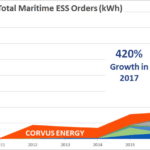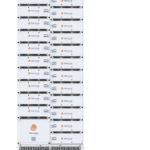Conditions are ripe for rapid growth in electric and hybrid marine technology. The world market for maritime ESSs grew 420 % last year
For the past five years, ship owners, charterers, maritime authorities, coastal governments and marine technology suppliers have strategically invested R[ds_preview]&D dollars into clean technologies and operational trials aboard both newbuilt and retrofitted vessels. We now understand the capabilities of these technologies to reduce fuel consumption, emissions and noise.
Battery-based Energy Storage Systems (ESS) have been at the heart of electric and hybrid energy sources for propulsion, backup power and house loads. We will look back on 2017 as a breakout year for the electric and hybrid marine technology industry. The world market for maritime ESSs grew an astounding 420% in terms of energy capacity. Corvus will supply over half of ESS capacity ordered – a total of over 45 MW.
Some examples for Corvus’ projects are:
• »North Sea Giant«, the first hybrid DP3 vessel – expected fuel savings is two million litres yearly
• »Viking Princess«, the first PSV to remove a generator and replace it with an ESS
• Seacor Marine PSVs, which will be the first hybrid PSVs to operate in the Gulf of Mexico
• Wärtsilä-designed hybrid fish farm processing and transport vessel, an industry first
• »Stena Jutlandica«, which will be the first Swedish ferry to operate emissions-free in harbour
• »Ampere«, the first all-electric ferry in the Norwegian fleet – one million litres of fuel not consumed yearly
Understandably, the industry proceeded cautiously for almost a decade, testing various technologies, collaborating with suppliers and maritime authorities to minimize risk and maximize performance. Hybrid and all-electric applications were tested one vessel at a time, systematically verifying performance, safety, and economic benefit.Now we’re seeing the results – and they’re good. Emissions reductions are as promised. Crew acceptance is better than expected. Fuel and maintenance savings are accumulating year after year, leading to quick investment payback in many applications. In conjunction with significant cost reductions in lithium-ion battery cells, the economics are now quite attractive. We’ll see ship owners make decisions about the rest of their fleets in 2018-2020, and there’s hardly a newbuild that will not have an ESS. The 100+ Corvus ESSs in the marine industry now total over 75 MWh and 1.5mill. operating hours.
Author: Sean Puchalski


















